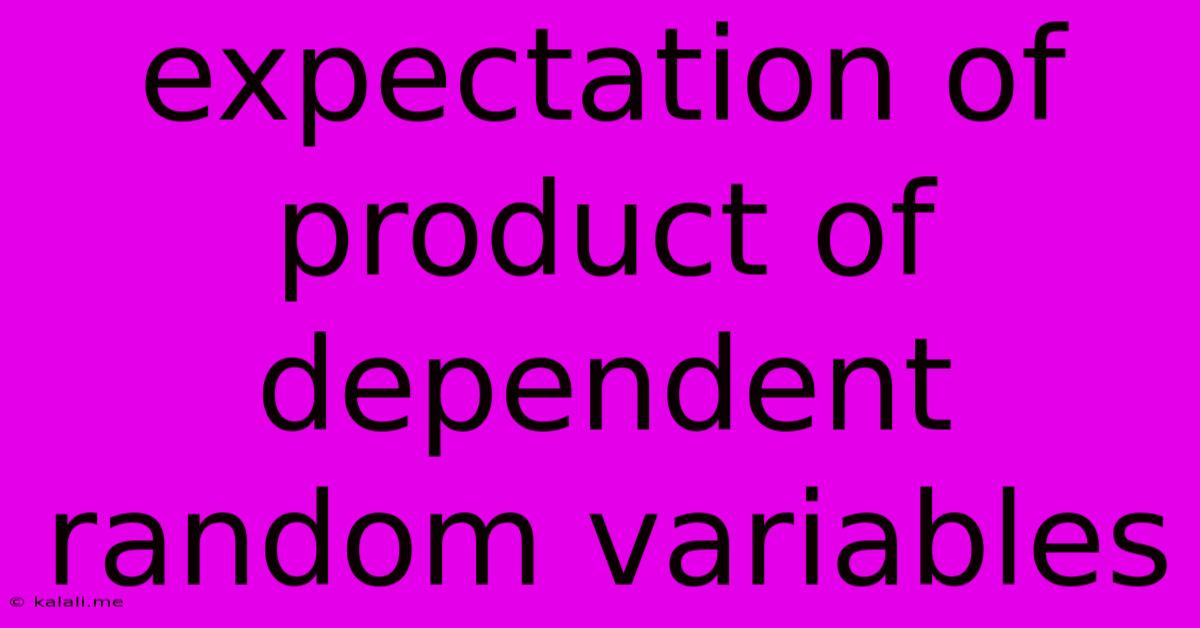Expectation Of Product Of Dependent Random Variables
Kalali
Jun 06, 2025 · 3 min read

Table of Contents
Expectations of Products of Dependent Random Variables: Beyond Independence
Understanding the expectation of the product of random variables is fundamental in probability and statistics. When the variables are independent, the calculation is straightforward: the expectation of the product is simply the product of the expectations. However, when dealing with dependent random variables, the situation becomes considerably more complex and requires a deeper understanding of conditional expectation. This article delves into the intricacies of calculating the expectation of products of dependent random variables, providing insights and illustrating with examples.
What Happens When Independence Fails?
The core issue stems from the fact that E[XY] ≠ E[X]E[Y] when X and Y are dependent. This seemingly simple difference introduces significant challenges. We can no longer rely on the simple multiplicative property. Instead, we must leverage the concept of conditional expectation.
Leveraging Conditional Expectation
The key to unlocking the expectation of the product of dependent random variables lies in the law of iterated expectations. This powerful tool allows us to break down the problem into more manageable parts. Specifically, we can express E[XY] as:
E[XY] = E[E[XY|X]] or equivalently E[XY] = E[E[XY|Y]]
This formula states that the expectation of the product XY can be found by first finding the conditional expectation of Y given X (or X given Y), and then taking the expectation of this conditional expectation. Let's break this down:
-
E[Y|X]: This represents the expected value of Y, given that we know the value of X. This is a function of X.
-
E[XY|X]: This is the expected value of XY given X. Since X is known, it can be treated as a constant. Thus, E[XY|X] = X * E[Y|X].
-
E[E[XY|X]]: This is the expectation of the expression we just derived, X * E[Y|X]. This is an expectation with respect to the distribution of X.
Illustrative Examples
Let's consider a couple of examples to solidify these concepts:
Example 1: Linear Relationship
Suppose Y = 2X + 1, where X is a random variable with E[X] = 2 and Var(X) = 1. Then:
E[XY] = E[X(2X+1)] = E[2X² + X] = 2E[X²] + E[X]
Since Var(X) = E[X²] - (E[X])², we have E[X²] = Var(X) + (E[X])² = 1 + 2² = 5.
Therefore, E[XY] = 2(5) + 2 = 12. Note that E[X]E[Y] = E[X]E[2X+1] = 2(2(2)+1) = 10 ≠ E[XY].
Example 2: More Complex Dependency
Consider two random variables X and Y with a joint probability distribution. Calculating E[XY] directly requires summing over all possible values of X and Y, weighted by their joint probability: E[XY] = Σₓ Σᵧ xy * P(X=x, Y=y). This can be computationally intensive depending on the complexity of the joint distribution. Using conditional expectation often simplifies this process.
Covariance and Correlation: Further Insights
The difference between E[XY] and E[X]E[Y] is directly related to the covariance between X and Y:
Cov(X, Y) = E[XY] - E[X]E[Y]
Covariance measures the linear relationship between two variables. A positive covariance indicates a positive relationship, while a negative covariance suggests a negative relationship. The correlation coefficient, a normalized version of covariance, provides a standardized measure of linear association between -1 and +1.
Conclusion
Calculating the expectation of products of dependent random variables requires a deeper understanding of conditional expectation and the law of iterated expectations. While direct calculation using joint distributions is always possible, leveraging conditional expectation often offers a more efficient and intuitive approach, particularly when dealing with complex dependencies. Understanding these concepts is critical for tackling numerous problems in probability, statistics, and related fields. The examples provided serve as a starting point for understanding and applying these principles to various scenarios involving dependent random variables.
Latest Posts
Latest Posts
-
Can I Put Water In My Coolant
Jun 07, 2025
-
How To Change Light Bulb Ceiling Fan
Jun 07, 2025
-
3 Places In Acts Where Conflict Occurred
Jun 07, 2025
-
1 2 Or 3 4 Water Supply Line
Jun 07, 2025
-
How Long Is A Rotation In Sstar Wars
Jun 07, 2025
Related Post
Thank you for visiting our website which covers about Expectation Of Product Of Dependent Random Variables . We hope the information provided has been useful to you. Feel free to contact us if you have any questions or need further assistance. See you next time and don't miss to bookmark.